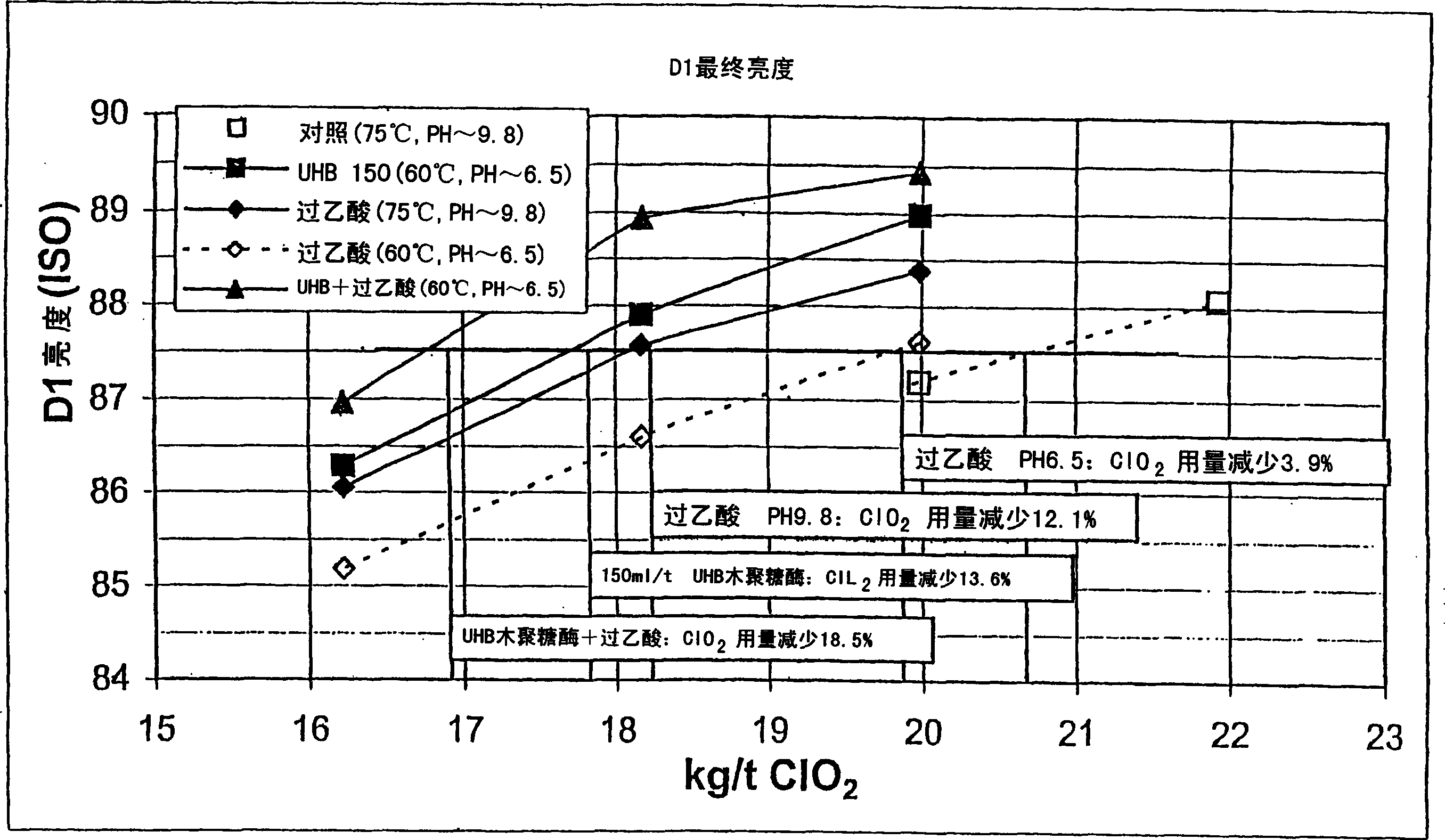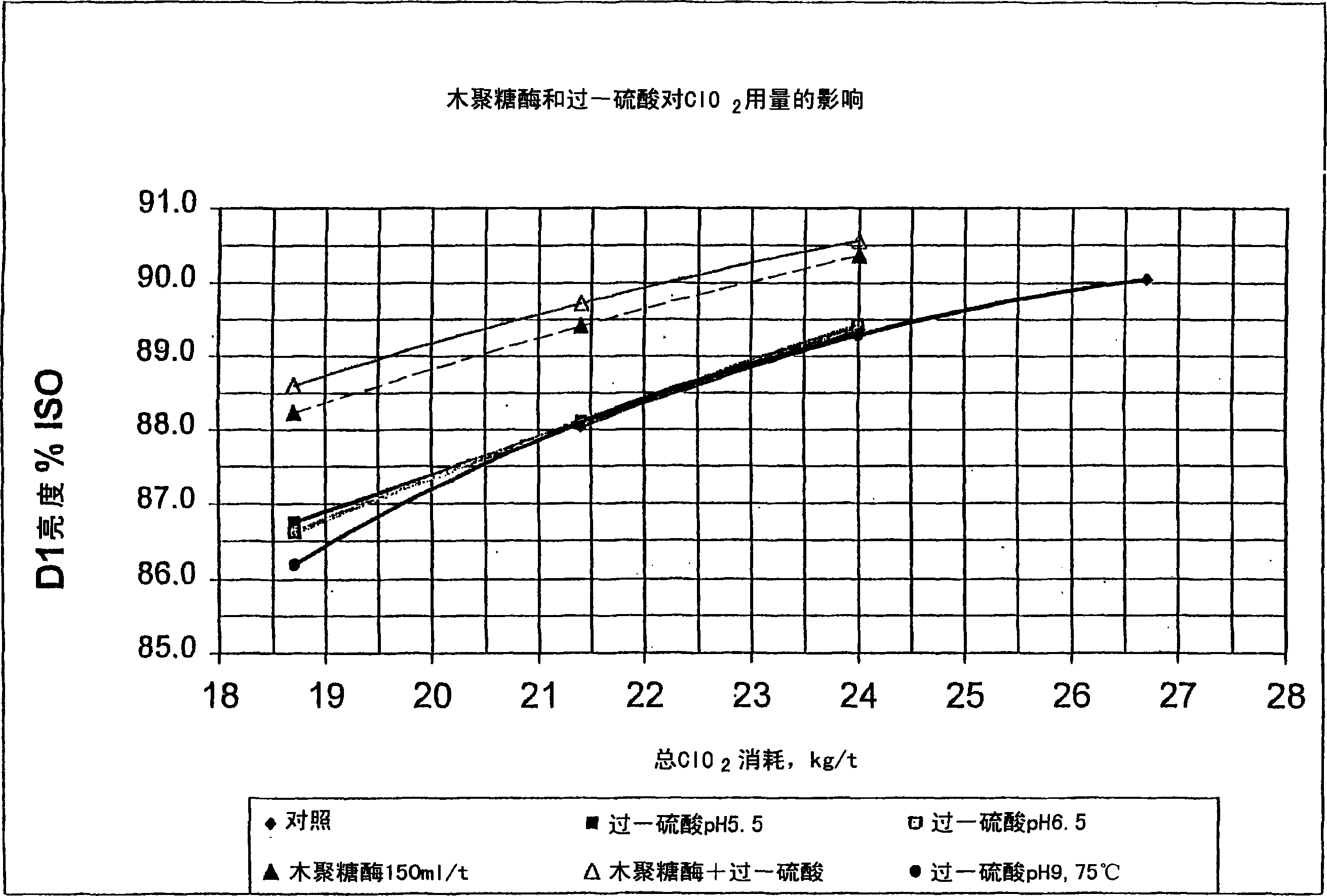Bleaching stage using xylanase with hydrogen peroxide, peracids, or a combination thereof
A technology of xylanase and hydrogen peroxide, applied in the field of bleached pulp
- Summary
- Abstract
- Description
- Claims
- Application Information
AI Technical Summary
Problems solved by technology
Method used
Image
Examples
Embodiment 1
[0078] Embodiment 1: the mensuration of kappa number
[0079] The Kappa number of pulp was determined using the TAPPI method for determining the Kappa number of pulp (T 236 cm-85) disclosed in TAPPI Test Method 1996-1997 (this test method is incorporated herein by reference). Briefly, the Kappa number is the volume (ml) of 0.1N potassium permanganate consumed by 1 g of dried pulp under the conditions specified in the method. The results were corrected for 50% consumption of the added potassium permanganate.
[0080] The measurement of the Kappa number is performed at a constant temperature of 25°C ± 0.2°C while stirring continuously. However, it is possible to correct for temperature changes as follows.
[0081] The moisture content of pulp was tested according to TAPPI T 210, "Sampling and Testing Wood Pulp Shipments for Moisture", which method is incorporated herein by reference. Briefly, pulp samples were dissolved in about 800 mL of distilled water and s...
Embodiment 2
[0099] Example 2: Standard analytical method for testing xylanase activity
[0101] The endoxylanase assay is specifically designed to measure the activity of endo-1,4-β-D-xylanase. When azoxylan is incubated with xylanase, when ethanol is added to the reaction mixture, the matrix is broken down to produce low molecular weight colored fragments, which remain in solution. High molecular weight substances were removed by centrifugation, and the color of the supernatant was measured. The activity of xylanase in the assay solution was determined with reference to a standard curve.
[0102] Matrix: The matrix was purified (to remove starch and beta glucan). Polysaccharides were stained with Remazolbrilliant Blue R to about 1 dye molecule / 30 sugar residues. Dissolve the powder matrix in water and sodium acetate buffer and adjust the pH to 4.5.
[0103] Analysis method: Dilute xylanase with 0.5M acetate buffer to pH 4.5. 2 mL of the solu...
Embodiment 3
[0107] Embodiment 3: the preparation of chlorine dioxide
[0108] In the laboratory, chlorine dioxide was produced according to the standard method of passing a mixture of chlorine and nitrogen through a series of columns filled with sodium chlorite and collecting the exhaust gas with cold water. Chlorine dioxide is stored frozen in water at a concentration of 10.4 g / L. Additional details on the preparation of chlorine dioxide can be found in Chlorine Dioxide Generation, published by Paprican, Pointe Claire, Quebec, (which is incorporated herein by reference).
PUM
 Login to View More
Login to View More Abstract
Description
Claims
Application Information
 Login to View More
Login to View More - R&D
- Intellectual Property
- Life Sciences
- Materials
- Tech Scout
- Unparalleled Data Quality
- Higher Quality Content
- 60% Fewer Hallucinations
Browse by: Latest US Patents, China's latest patents, Technical Efficacy Thesaurus, Application Domain, Technology Topic, Popular Technical Reports.
© 2025 PatSnap. All rights reserved.Legal|Privacy policy|Modern Slavery Act Transparency Statement|Sitemap|About US| Contact US: help@patsnap.com


